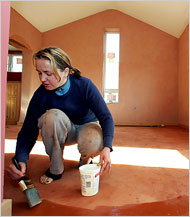I just uncovered a New York Times article on earthen floors. It is cool because it mentions the person who is consulting with Eco Brooklyn on some earthen floors in Brooklyn and Harlem. Her name is Sukita and she is very knowledgeable in earthen floors.
We have done some experimenting to adjust a typically dry climate green building technique to the North Eastern US climate of New York. But earthen floors have been built extensively in Portland Oregon where it can also get humid and you have to worry about rain, so we are pretty confident our earthen floors will do very well in New York.
I am excited by earthen floors as a replacement to Brownstone concrete slabs in the basement. Concrete has huge embodied energy. Earth has none if you get it from the basement.
The green aspect and the aesthetic aspect of an earthen floor is a no brainer.
The one challenge we address is the potential of flooding in the basement. An earthen floor would not fare as well as concrete. To overcome this we design your typical layers that a concrete floor would have but we add an interior gravel buffer drainage layer, not for exterior flooding but for water that may come from inside the house.
First you dig out and level the basement ground earth floor. Then you lay gravel so that any ground water can pass away. Then you put a vapor barrier to keep out ground humidity and argon. After that things change a little. You put the extra gravel buffer layer. Notice it goes up all the way on the side. This will drain and hold a certain amount of water flooding from inside the house and reduce the amount of water the earth floor will sit in.
This in house gravel layer would have a humidity alarm line put into it with an external battery powered unit that is easily accessible to replenish the batteries. This sounds fancy but it is no more complicated than an off the shelf smoke alarm so all home owners will understand how to maintain it.
The idea is that say a pipe breaks the gravel buffer layer will allow for a lag time before the water starts harming the earthen floor. During that lag time the alarm will be making noise, hopefully alerting the homeowner in time to shut off the flood. Should there be a lot of water in the gravel layer we could insert a hose and suck it out. The humidity would then be pulled out of the basement by a constantly running dehumidifier.
It is not failsafe. A flood is a drag no matter what the flooring. But should the earth get flooded it is not the end of the world. It will dry out and possibly need the top refinished. Worse case scenario the soil needs to be redone. But these are not vastly expensive. An earthen floor is in the same range as a concrete floor with huge improvements ecologically and aesthetically.
So we are hopeful our examples will pave the way for many more earthen floors in New York and many less concrete ones. There are too many benefits not to do it.


